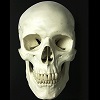6.4: Aging of the Postcranium
- Page ID
- 11460
Few options are available in aging the postcranium including epiphyseal union, bone measurements in infants, and degenerative change. Bone measurements exist for information. Degenerative change in the postcranium is similar to that seen in the articulation sites in the skull, with osteophytosis and erosion. Epiphyseal union can be extremely helpful in agin if no dentition is present or if you are working with a commingled burial. Presence absence, and fusion of the epiphyses to the shaft of the bone is relatively easy observation; see below for further information on aging using fusion of the epiphyses.
Epiphyseal Union
As a child an individual may have up to 600 separate bones, but by adulthood only 206 are present. This is due to the fact that there are both primary and secondary centers of ossification; as an individual ages the secondary centers will fuse to the primary centers. Below are some age estimates for when epiphyseal union occurs:
Clavicle - Sternal epiphysis fused by 25 years of age (Bass 1995)
Femur - Head and greater trochanter fused between 14 - 19 years of age (Bass 1995)
Fibula - Proximal epiphysis fused by 14 - 22 years of age, Distal epiphysis fused by 11 - 20 years of age (Bass 1995)
Humerus - Head fused by age 24 years of age, Medial epicondyle fused by age 19 years of age, Distal epiphysis fused between 17 - 18 years of age (McKern and Steward 1957)
Illiac Crest - Fused by age 23 (McKern and Stewart 1957)
Innominate - Pubis to ischium fused between 7 - 8 years of age, Fusion of the pubis/ischium/ilium at the acetabullum by at least 17 years of age (Bass 1995)
Ischial Tuberosity - Fused by age 24 (McKern and Steward 1957)
Radius - Proximal epiphysis fused between 16 - 18 years of age, Distal epiphysis fused between 16 - 18 years of age (Bass 1995)
Ribs - Head and articular end fused between 18-24 years of age (Bass 1995)
Sacrum - Fuses from inferior to superior between the ages of 18-25 (Bass 1995)
Tibia - Proximal epiphysis fused between 14-23 years of age, Distal epiphysis fused between 13-20 years of age (Bass 1995)
Ulna - Proximal epiphysis fused by 19 years of age Distal epiphysis fused between 17-20 years of age (Bass 1995)


